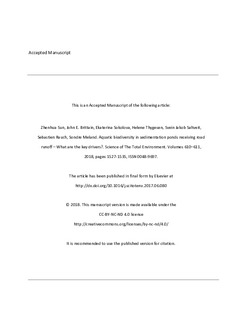Aquatic biodiversity in sedimentation ponds receiving road runoff - What are the key drivers?
Sun, Zhenhua; Brittain, John Edward; Sokolova, Ekaterina; Thygesen, Helene; Saltveit, Svein Jakob; Rauch, Sebastian; Meland, Sondre
Journal article, Peer reviewed
Accepted version
Permanent lenke
http://hdl.handle.net/11250/2494300Utgivelsesdato
2017Metadata
Vis full innførselSamlinger
- Publikasjoner fra Cristin - NIVA [2149]
- Scientific publications [1172]
Originalversjon
Science of the Total Environment. 2017, 610-611, 1527-1535. 10.1016/j.scitotenv.2017.06.080Sammendrag
Recently, increased attention has been paid to biodiversity conservation provided by blue-green solutions such as engineered ponds that are primarily established for water treatment and flood control. However, little research has been done to analyse the factors that affect biodiversity in such ponds. The purpose of this study was to evaluate the influence of environmental factors on aquatic biodiversity, mainly macroinvertebrate communities, in road sedimentation ponds in order to provide a foundation for recommendations on aquatic biodiversity conservation. Multivariate statistical methods, including unconstrained and constrained analysis, were applied to examine the relationships between organisms and the water quality as well as physical factors (including plant cover). Stepwise multiple regressions indicated that the most important variables governing the variation in the biological community composition were pond size, average annual daily traffic, metals, chloride, distance to the closest pond from study pond, dissolved oxygen, hydrocarbons, and phosphorus. The presence of most taxa was positively correlated with pond size and negatively correlated with metals. Small ponds with high pollutant loadings were associated with a low diversity and dominated by a few pollution tolerant taxa such as oligochaetes. A comprehensive understanding of impacts of various environmental factors on aquatic biodiversity is important to effectively promote and conserve aquatic biodiversity in such sedimentation ponds. Our results indicate that road sedimentation ponds should be designed large enough, because large ponds are likely to provide a more heterogeneous habitat and thus contain a species rich fauna. In addition, larger ponds seem to be less contaminated due to dilution compared to smaller ponds, thereby maintaining a higher biodiversity. Finally, creating some additional ponds in the vicinity of the sedimentation ponds in areas with few water bodies would increase the connectivity that facilitates the movement of invertebrates between ponds.
Beskrivelse
This is an Accepted Manuscript of an article published by Elsevier in Science of the Total Environment, available online: https://www.elsevier.com/

